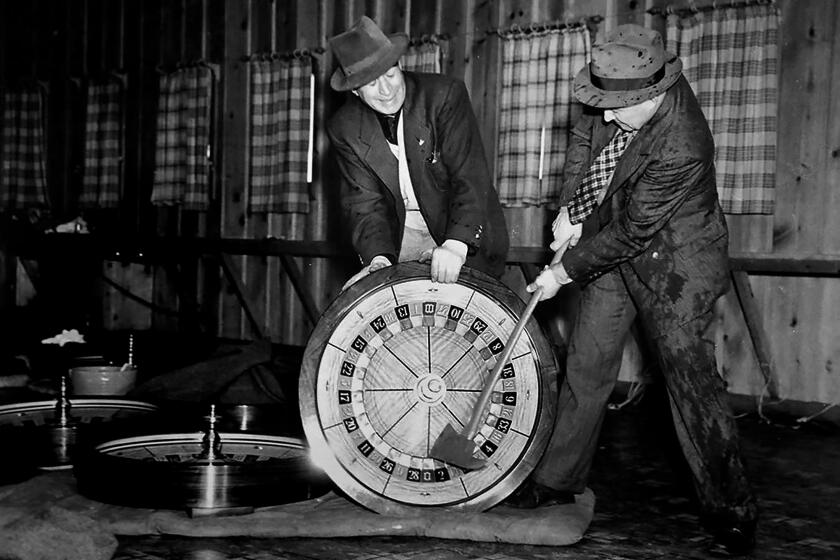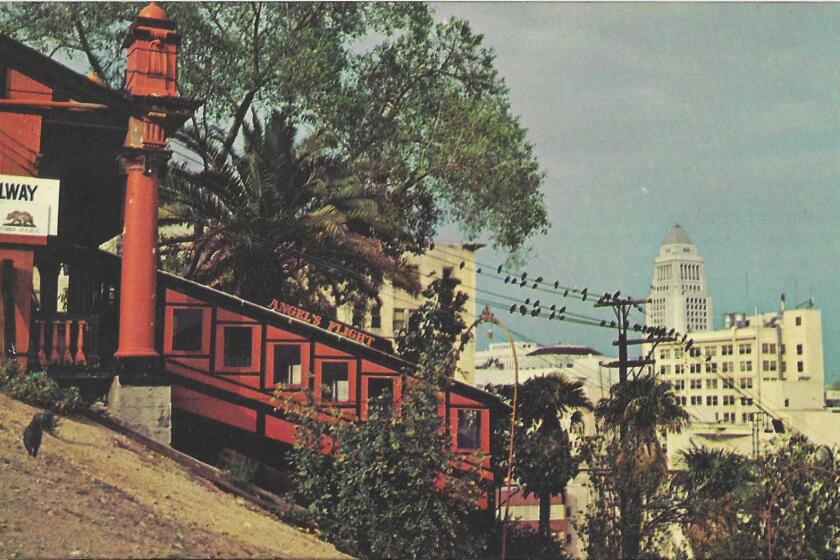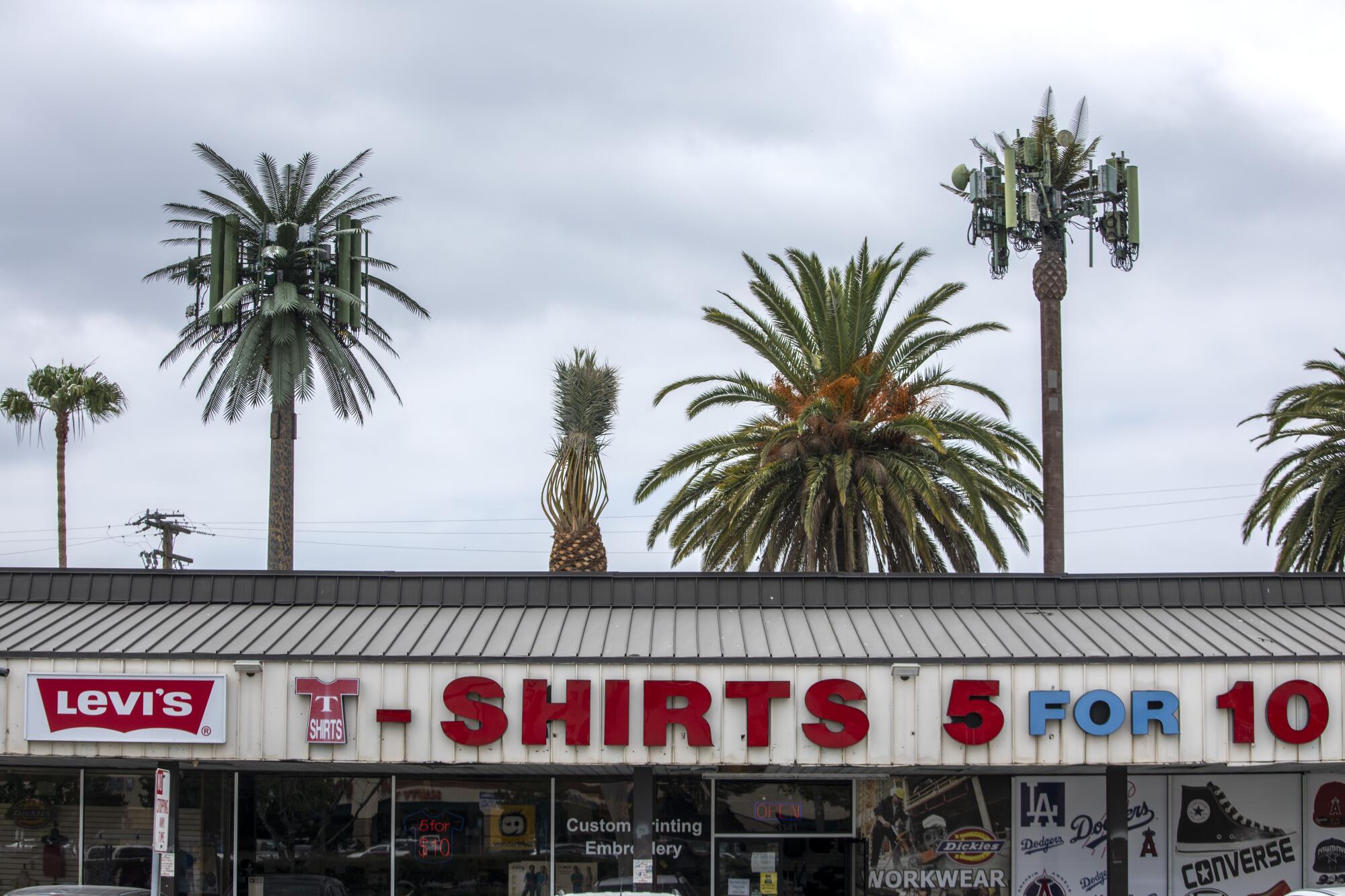
A gentle breeze rustles the eucalyptus tree, its dark green foliage quivering under a cloudy Santa Ana sky. At the base of its sturdy trunk, the leaves of a fallen branch bear the scars of hungry insects.
A stand of eucalyptuses sways across the road. But this tree, surrounded by a spiky metal fence, isn’t like the others.
“AT&T authorized personnel only!” a sign warns.
This tree isn’t actually a tree at all — it’s a cellular transmission tower, one among hundreds or more that now blanket Southern California.
Cell tower trees have become an indelible part of the L.A. landscape over the last few decades, sprouting beside freeways and in the city’s other in-between spaces. The demand for calls that never drop and videos that always stream is fueling the growth of these structures, whose fake foliage is meant to obscure the rectangular antennas clustered near their tops.
Their ersatz nature leaves some Angelenos amused and others bemused. It takes little more than a glancing look to sense they don’t photosynthesize — and the whole charade definitively falls apart when comparing them with real trees.

But how often do people stop to look at trees?
This unnatural flora has spread because of a quirk of telecommunications law: municipalities cannot, in many cases, reject a cellular carrier’s request for a new tower, but they can require it to be concealed.
The proliferation of the stealth towers has invited philosophical questions about humankind’s dominion over the natural world and the role of technology in modern life. And in L.A., a city known — unfairly or not — for its artificiality, the tree tower has become an emblem. Especially the palm trees.
“To me, the cell tower palm tree seems like the best symbol of Los Angeles for the 2000s,” said Kazys Varnelis, a historian of cities and communications. “It is that city of fakeness.”
When Varnelis had to choose cover art for “The Infrastructural City,” a collection of essays on L.A. that he edited, he knew what he wanted: a palm tree cell tower.
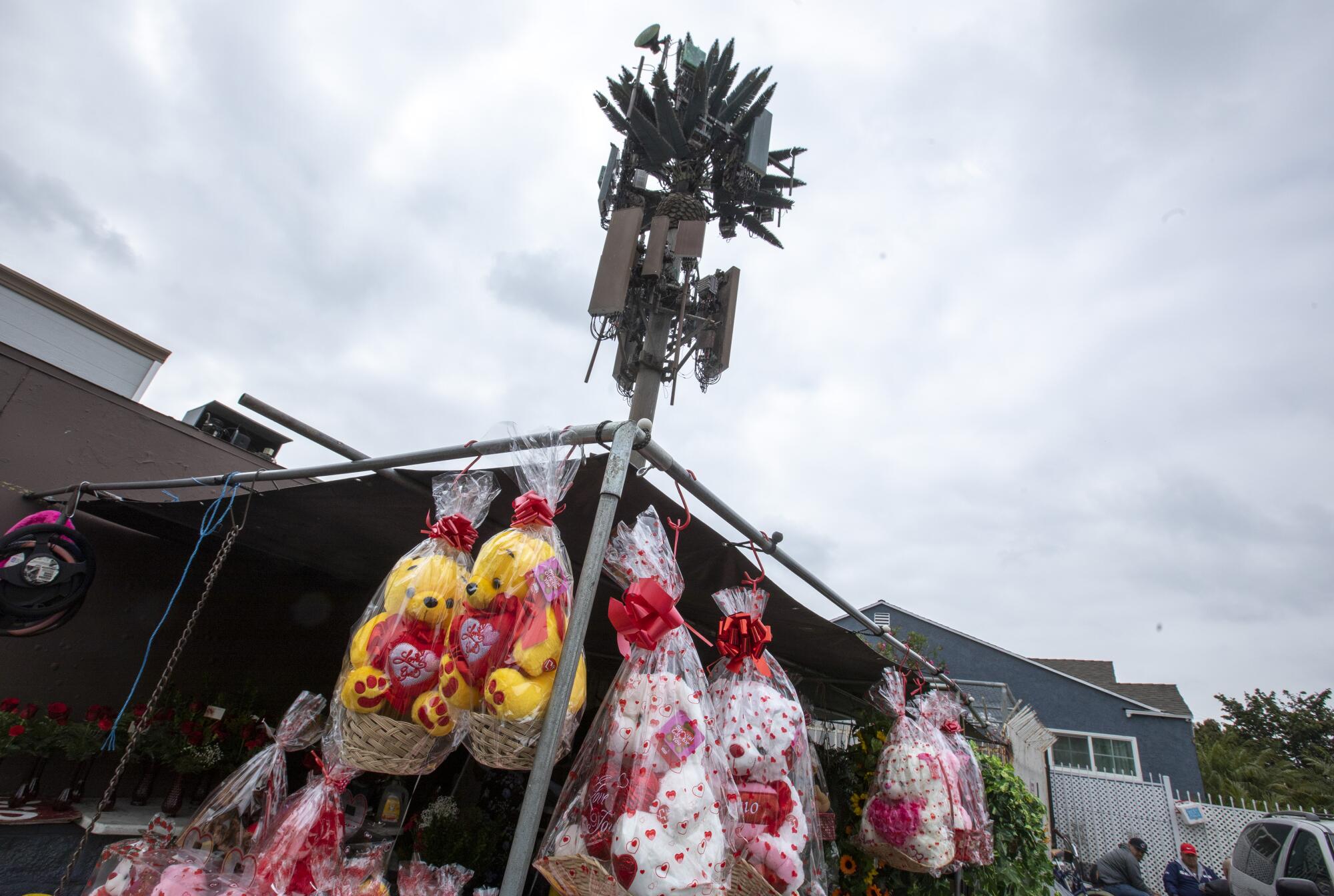
“Nobody is fooling anybody — it is a gorilla in a tutu at the ballet — but somehow it allows people to feel a little better.”
Indeed, the towers are viewed by many city officials and constituents as a visual improvement on their conventional brethren — metal structures, known as monopoles, topped by a tangle of cables and antennas.
Subscribers get early access to this story
We’re offering L.A. Times subscribers first access to our best journalism. Thank you for your support.
This niche trade is maturing: Tree towers are evolving to become more complex and realistic as jurisdictions demand improved options and fabricators compete for business. It makes for a level of detail that impresses May Plummer, who works at the Santa Ana business park that houses the eucalyptus tower.
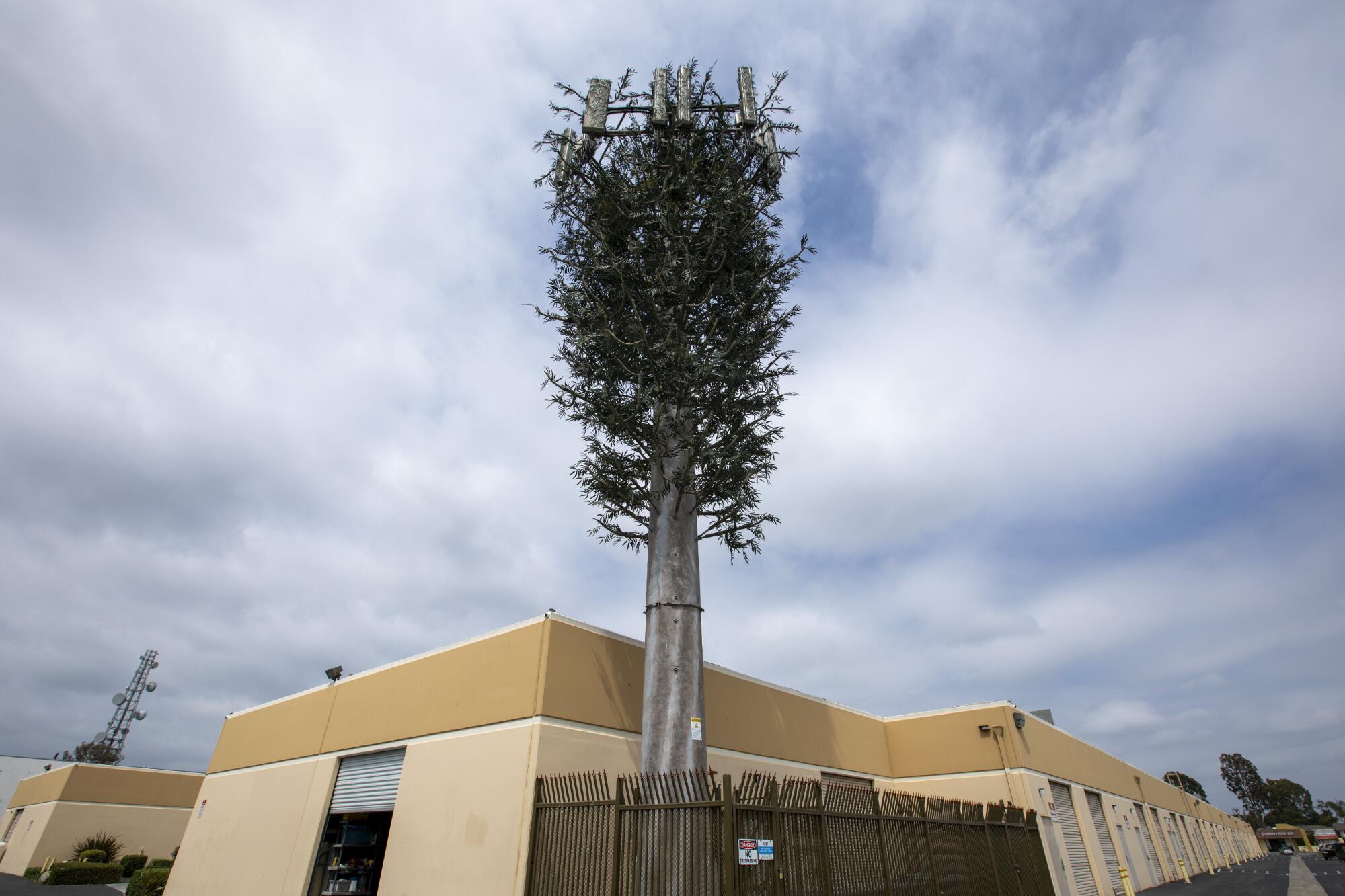
“I love nature — at first it was like, ‘OK, does it really look like a tree?’” said Plummer, co-owner of Patio Furniture Refinishers. “I think it does.... It blends in.”
Try telling that to a botanist.
“From about five miles away, there’s a possibility I could maybe mistake them for a real tree. But up close, no, not at all,” said Frank McDonough, a botanical information consultant at the Los Angeles County Arboretum and Botanic Garden, who recently visited several tree tower sites with The Times. “They don’t remind me of any species at all.”
Made from metal, fiberglass and plastic, the structures in L.A. usually rise 65 to 75 feet, top out at about 120 feet and can come with six-figure price tags. They are, Wireless Infrastructure Assn. Chief Executive Jonathan Adelstein said, “the last choice of a tower builder, but they might be the first choice for the local authorities.”
Tomy’s Hamburgers. Tom’s Number 5 Chiliburgers. Tam’s Burgers. Tommy’s Famous Drive-Thru.
“Cell towers don’t grow on trees — they are costly to build in the first place, but if you need to go through these concealment efforts, they are even more” expensive, said Adelstein, adding that tree towers can cost up to double a conventional array of the same height.
There are no universal rules for cell towers’ design, and jurisdictions have different requirements. The city of Los Angeles requires that wireless telecommunications facilities “have the least possible visual impact on the environment.” It mandates that towers be designed with stealth techniques, which may include camouflaging them to look like trees. (Other stealth options include faux water towers, rock formations and windmills.)
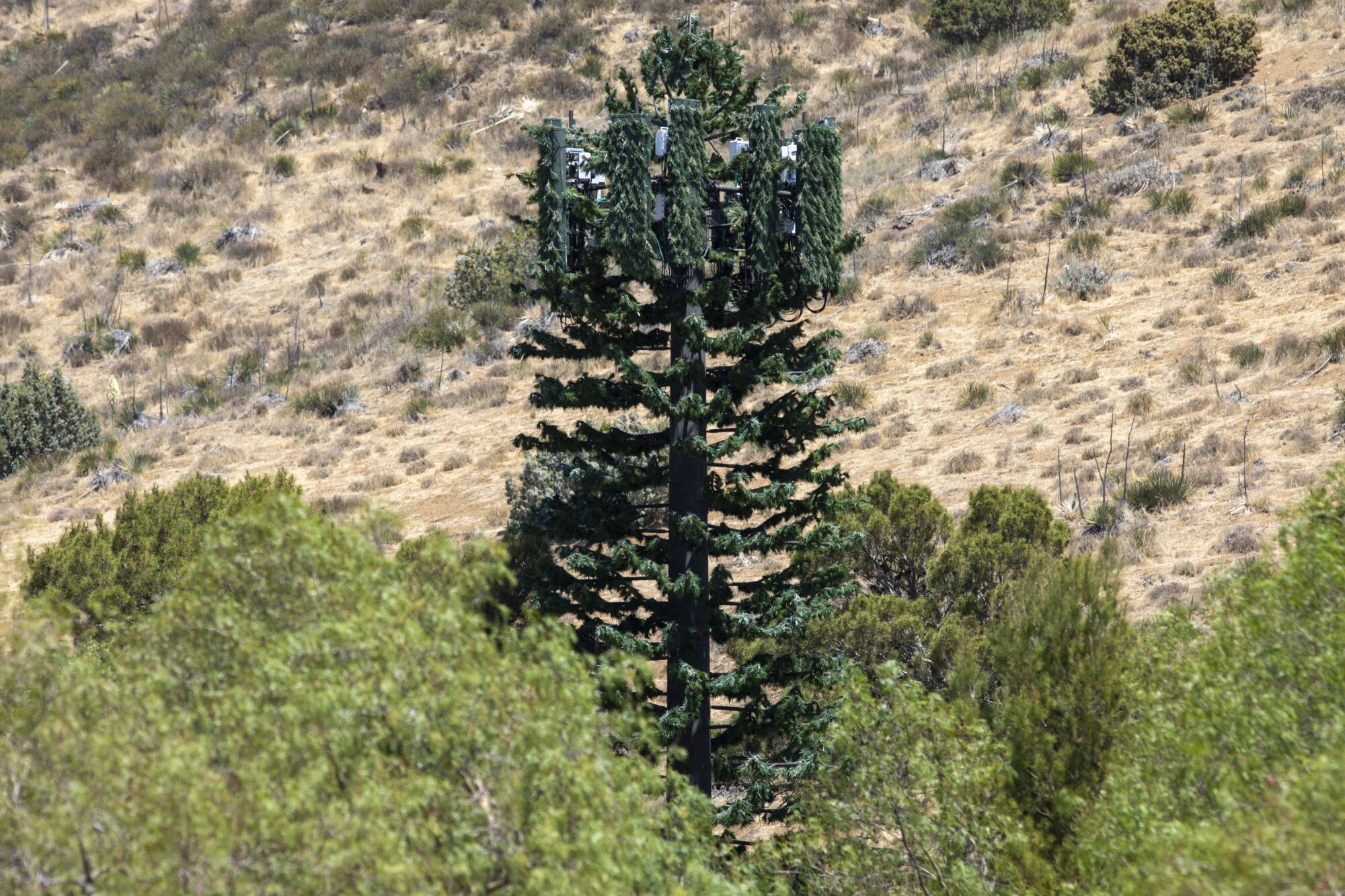
A tally for the number of tree towers nationwide doesn’t exist, but they appear to have spread at a rapid clip over the last decade. A report by Vox said there were as many as 2,000 in the U.S. in 2013. Now, just one carrier, AT&T, said it has hundreds in L.A. and thousands across the country. Meanwhile, Tucson-based Valmont Larson, a major producer of camouflaged cell towers, said that it has developed more than 10,000 concealed cellular transmission sites across the country, a majority disguised as trees.
Still, the tree towers present an existential conundrum: The aim of this technology is to make other technology less noticeable. But we do notice them.
“Who are you for?” Curbed’s California correspondent Alissa Walker asked the Santa Ana eucalyptus tower during a tour with The Times.
And though an untold number of phone calls were being answered via that tower, it couldn’t give Walker one.
‘Hey, this cactus is humming’
Among the handful of concealment specialists fabricating tree towers in the U.S., Valmont Larson has the deepest roots in the industry: A company it acquired in 2019 created what is believed to be the first one in the world.
The pine tree tower was developed in Monument, Colo., in 1992 by Larson Co. It arose after officials in Monument, concerned about the appearance of a proposed cellular tower, rejected a carrier’s request for a permit, said Mark R. Schmidt, general manager of Valmont Larson, a business of infrastructure services giant Valmont Industries.
“Someone at the carrier asked, ‘Hey, if we were to find a way to conceal this tower, would you consider it?’” Schmidt said.
The carrier reached out to Valmont and Larson, then separate companies. At Larson, which made its name building artificial landscapes for theme parks, aquariums and zoos, a now-deceased employee named Larry Hibler took the lead. The project ultimately relied on the company’s expertise in camouflage and Valmont’s experience with pole construction.
The business has come a long way since then. In 2005, Larson Co. spun off its concealment operation into a new venture called Larson Camouflage that was acquired by Valmont Industries two years ago and renamed Valmont Larson. The company declined to disclose details of its financial performance, but its publicly traded parent, Omaha-based Valmont Industries, reported revenue of $190 million for its communications products business segment in 2020.
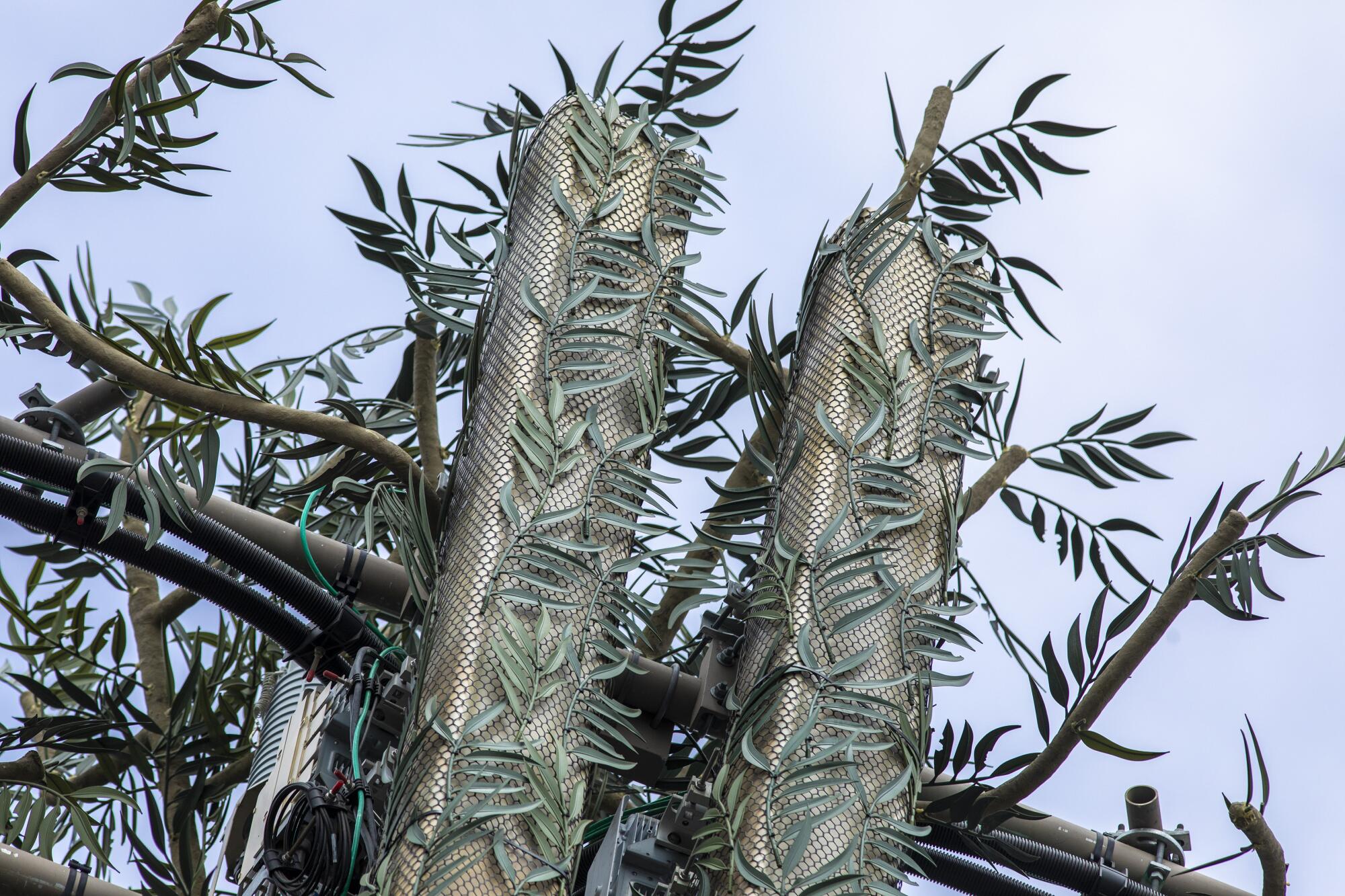
The stealth towers themselves have made great strides too. Valmont Larson’s innovations have included the development of asymmetrical leaves “to mimic what you would see in nature,” and it has consulted with arborists who have provided input on its efforts, Schmidt said. For the company’s eucalyptus design — the one that features leaves with simulated bug bites — each tower has a mix of unmarred “new growth” leaf clusters and bite-riddled “mature” ones, Schmidt said.
“Nature provided that guidance,” he said.
The company can accommodate special requests from customers — typically third-party tower developers and carriers — whose projects must adapt to particularly unique landscapes. One client in Monterey County requested a trio of dead trees, called “snags,” Schmidt said. The towers, built in 2005, were situated in an area trafficked by golfers, and the client wanted a design that would completely hide the cellular equipment while also blending into the natural environment.
“There’s no foliage on the trees at all,” Schmidt said. “The handful of branches that are there really look like broken, cracked and rotting wood. And it was exactly what our customer wanted.”
One of the company’s offerings is modeled after a saguaro cactus, simulating the Sonoran Desert native’s color variation and needle clusters. So much so, Schmidt said, that people have been unnerved by noises emanating from the towers.
“We’ve had instances where ... our customers have gotten calls [saying], ‘Hey, this cactus is humming. It’s making a sound,’” Schmidt said. “And it turns out it’s one of our cacti, and there are some fans running in it.”
But the goal isn’t necessarily to fool people, he said.
“It’s not our intention to compare a natural tree to our tree and say, ‘You can’t tell the difference,’” he said. “We can get really close. But at the end of the day, it’s not a natural tree, it is a man-made structure that is just meant to blend in as best as possible.”
A complex ecosystem
In the quarter century since the passage of the Telecommunications Act of 1996, which set rules for wireless infrastructure development, mobile communication has exploded — as has the need for systems that make it possible.
The trouble is, Adelstein said, “the easy towers have all been built.”
“Now they are trying to get deeper into a suburban area,” he said. “We are getting deeper into the difficult territory where there is more resistance locally.”
Thus is the predicament: “Everybody wants the cell site, just no one wants to see it,” said Terry Stenzel, vice president of AT&T Southern California.
For AT&T, that has necessitated a balancing act, as the company juggles the data needs of consumers and the aesthetic desires of municipalities.
In Garden Grove, cell towers must be camouflaged — and that has typically meant pine and palm towers, said Lee Marino, the city’s planning services manager. (Smaller antenna installations — the sort that can be tucked away on rooftops and other structures where they are out of sight — don’t need to be disguised.)
The aesthetics of a proposed cell tower are considered ahead of the planning commission’s vote on permit approval. And there is oftentimes a “back and forth” between the city and the tower builder over the look of the project, Marino said.
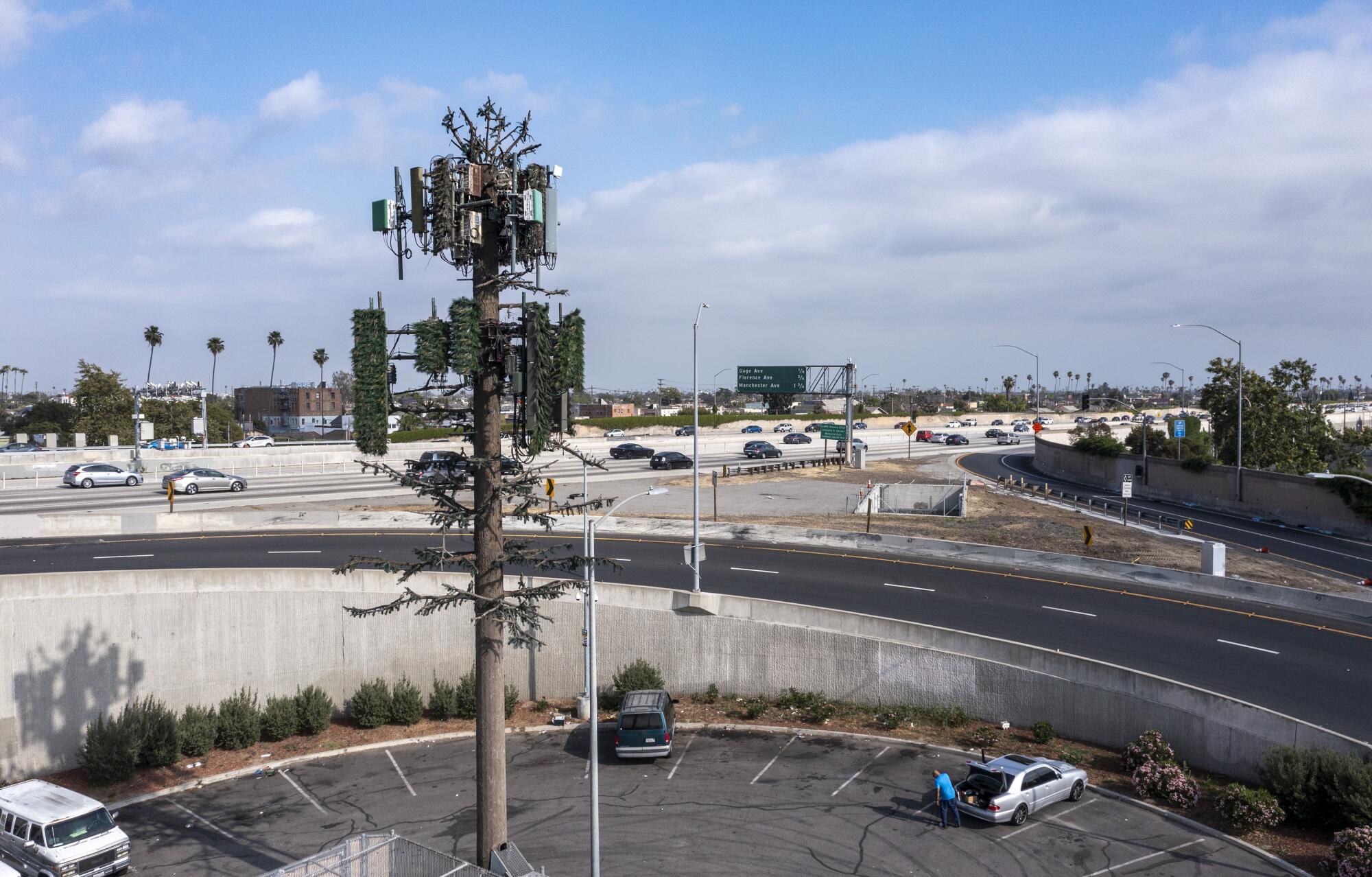
“When they are talking about trees — well, what’s around it?” Marino said. “And if they are putting in a palm tree and it is the only one around, we will ask them, ‘Can you put in a few others — real ones?’”
Neighboring Santa Ana mandates that all cellular communications facilities on private property be stealth in design. It’s a matter of “community values,” said Paul Eakins, a city spokesman.
In explaining what that actually meant, Eakins cited Santa Ana’s large population of mature trees and its designation for 22 straight years as a Tree City USA — an honor for cities that observe Arbor Day, among other requirements.
“We want to preserve that essential character of our city by requiring that these wireless towers blend in to our urban forest,” Eakins said.
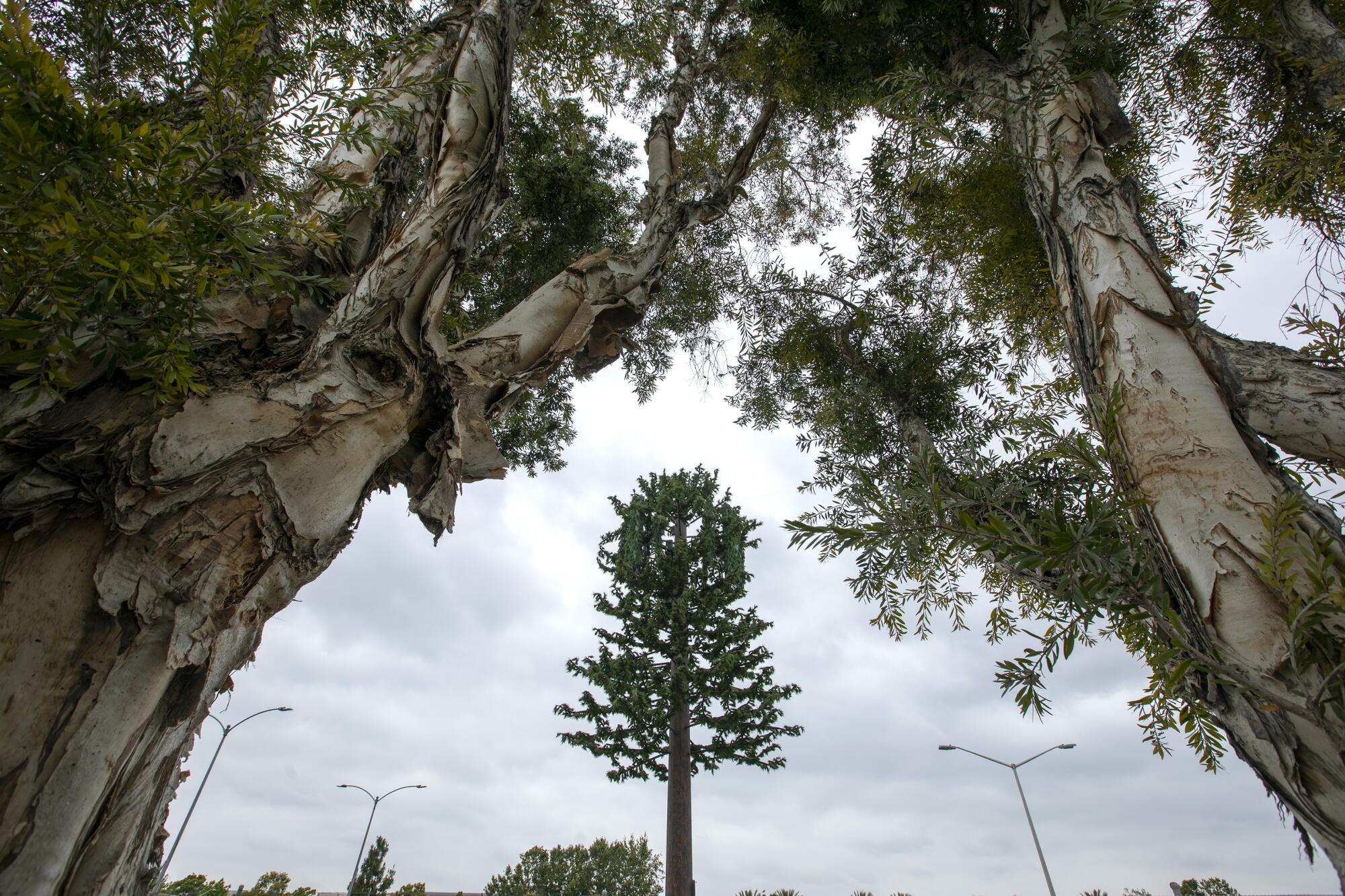
Across the country, towers are, in most cases, owned by telecommunications companies or third-party developers, among them American Tower Corp., Crown Castle and SBA Communications Corp. These companies pay for the construction of the structures and then rent space on them to cellular providers. The developers may own the land where their towers are sited or lease it from others, Adelstein said.
Companies such as Valmont Larson are hired to build the tree towers that adorn the developers’ and cellular carriers’ sites. The structures may look simple, but their construction is complex because some conventional materials could interfere “with the purposes of the tower,” Adelstein said. “You have to have things that are light and airy. You have to stand the test of weather. It is brutal.”
Schmidt said that Valmont Larson has developed special resins for simulated bark that can better withstand changing weather, helping the towers keep up appearances much longer.
“We have trees out there that have bark that’s still intact 20 years later,” he said.
The philosophical debate
A flock of feral parakeets screeched through the Garden Grove skies before settling in a small grove of palm trees behind a clothing store selling Levi’s and Dickies. Most of the birds favored one of the live palms — but a few roosted in a neighboring date palm tower created by Valmont Larson.
Curbed’s Walker, who writes about urban design, watched the activity as she ruminated on L.A.’s complicated relationship with the palm tree — real and fake ones alike.
The palm tower, she said, is “the iconic cellphone tower as tree that most people know.” And she liked the look of Valmont Larson’s version.
“The antennas are packed very well into the crown of the tree, and it’s fairly convincing — the fronds are very good,” she said. “It has got the shape nailed in a way that might fool you.”
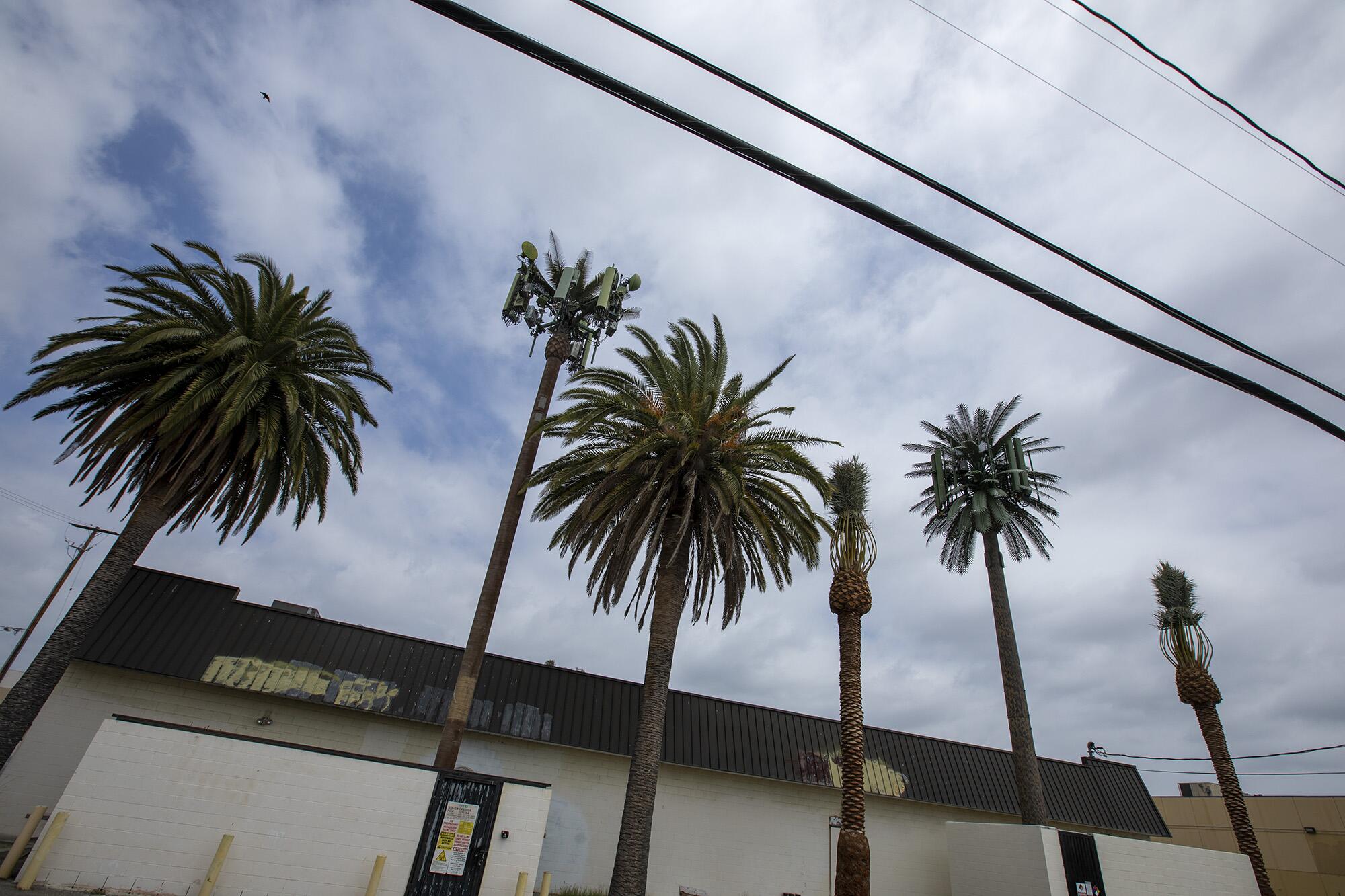
But Walker found it ironic that the simulated palm has become so prevalent in L.A. — because it is mimicking a tree that isn’t supposed to be here. Though the live palm has become the Southland’s signature tree, of the many varieties growing in Los Angeles, only the California fan palm is native to Southern California, and it doesn’t even naturally occur in L.A.
Gesturing at a real date palm, Walker said: “They have become part of our landscape in a way we don’t really question.”
That’s sort of like the utility pole — an early piece of telecommunications infrastructure that changed the look of the built environment. Few pay them any mind. Those structures, however, are seldom camouflaged to look like something from the natural world.
So why the urge to disguise cell towers?
In an era of conspiracy theories about 5G technology, Varnelis said that camouflaging transmission towers as trees may be a precautionary measure. Last year, dozens of cell towers were torched across Europe amid false theories linking 5G to the spread of COVID-19.
Water-cannon gangsters, booze-soaked vice dens: How 1939’s ‘Battle of Santa Monica Bay’ brought down L.A.’s floating casinos.
“People are certainly afraid of them,” Varnelis said. “There is definitely concealment for that purpose.”
But technology is nothing to hide, argued McDonough, the L.A. Arboretum botanist, adding that it “is part of who we are as an organism on this Earth.”
He believes that tree towers are an unnecessary attempt “to ameliorate what we feel is our negative effect” on the environment. McDonough would prefer that cell towers were not camouflaged and instead displayed their antennas as symbols of man’s ingenuity. But he thinks a sense of guilt has driven their creation.

“We have to be really careful about attempts to assuage our guilt, when we should be looking at the guilt and saying, ‘Why do we have it?’” he said.
(In the time it has taken you to read this far — perhaps on a mobile phone — about 475 acres of forest have been lost worldwide, extrapolating deforestation data from a 2020 United Nations report.)
As our forests disappear, the simulated trees are becoming more convincing — though some towers, by virtue of their placement, always seem more out of place than others. Faux pines set amid parched hillsides dusted with browning chaparral can feel jarringly incongruous, for example. Botanist Terry Huang, assistant director of the UCLA Mildred E. Mathias Botanical Garden, said he’s curious to see how much more realistic tree towers can become. But his curiosity comes with some dread.
“For me, it’s like hiding something,” Huang said. “When we are losing the distinction of what is ‘natural,’ and what is made by us, that’s where it is a little uncomfortable for me.”
While botanists may wring their hands, companies such as Valmont Larson continue to seek out technology that could make the tree towers more lifelike.
Everybody knows Angels Flight. But what about Court Flight? Or the Mt. Washington Railway? Or the Catalina Island funicular? Here’s the story of the cars that climbed Southern California’s hills and the automobiles and other calamities that all but made them extinct.
Schmidt said that the company previously engaged a scientist working in nanotechnology to develop fake foliage that would change colors based on the temperature, mimicking deciduous trees. “As the temperature would get down below freezing, [the leaves] would turn like a dark red color from a dark green color,” he said.
But there was a problem: after deciduous trees’ leaves change colors with the season, they fall off. Such a feat wasn’t feasible for a cellular transmission tower.
“If it got really cold, what we found was that the tree ... just had the red leaves on it all the time,” Schmidt said.
Valmont Larson never released the color-changing foliage. In this area, nature still has the edge.
Watch L.A. Times Today at 7 p.m. on Spectrum News 1 on Channel 1 or live stream on the Spectrum News App. Palos Verdes Peninsula and Orange County viewers can watch on Cox Systems on channel 99.
More to Read
Inside the business of entertainment
The Wide Shot brings you news, analysis and insights on everything from streaming wars to production — and what it all means for the future.
You may occasionally receive promotional content from the Los Angeles Times.


